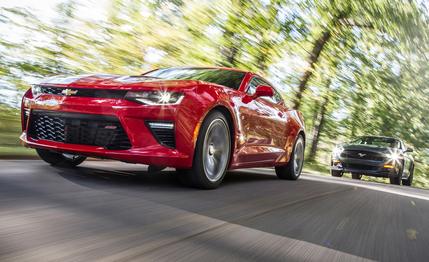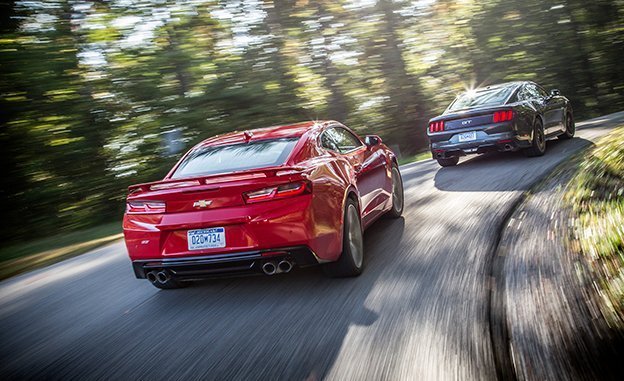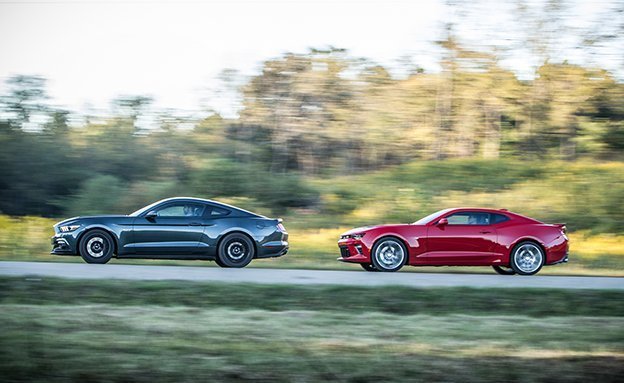 Comparison Tests
From the December 2015 issue
Comparison Tests
From the December 2015 issue
There was a time when the American muscle car performed all its tricks with the steering wheel pointed straight ahead. Detroit iron built its image on burnouts, quarter-mile runs, looking fast while parked, and chasing pedestrians out of the crosswalk with a prod of the throttle.
But if it weren’t for that V-8 snarl and their burly bodywork, today’s muscle cars might pass as legitimate sports cars. America’s blue-collar heroes still charge hard in a straight line, but they now corner with the confidence of a European coupe. It’s the result of decades-long evolution, but also recent strides in chassis dynamics.

Ford’s breakthrough arrived in 2014, just in time for the Mustang’s 50th birthday, when engineers included for the first time an independent rear suspension across their entire pony-car lineup. They created the most civilized, the most docile, and the most tossable Mustang outside of the odd be-stallioned track-day special. The 2016 edition is essentially unchanged from the car introduced two years ago, although it has spawned the race-bred Shelby GT350 and GT350R, cars that smear the distinction between juiced-up muscle and flexible sports cars into an indistinguishable blur of racing stripes and eight-cylinder thunder.
As it was in the beginning, so it is now: Just like in the ’60s, Ford’s Mustang success has Chevrolet playing catch-up with its new Camaro. The Chevy V-8 now turns out an additional 29 horsepower, but it’s clear that the engineers directed most of their energy toward the chassis. Reborn on GM’s Alpha platform, the new, sixth-generation Camaro uses the same core that forms the basis of the German-baiting Cadillac ATS and CTS. It is lighter and trimmer than the Zeta-platform-based Camaro it replaces and benefits from the suspension and steering expertise that is quickly—and surprisingly—becoming a GM hallmark.
We left the Dodge Challenger on the bench for this test. After its third-place finish in our December 2014 comparison, where a similarly equipped Mustang took the gold, we knew where the Challenger would place in this round. If it wants to run with these two athletes, Dodge needs to cut the fat. The Challenger is more than nine inches longer than either car here and weighs some 400 pounds more.

For this test, the manufacturers provided the top-performing versions of the common man’s V-8 muscle car. For Chevrolet, that means a Camaro SS with the 455-hp, 6.2-liter V-8 equipped with magnetorheological dampers ($1695) and the eight-speed automatic transmission ($1495). The $895 dual-mode exhaust doesn’t make the car any more powerful, but it delivers a Metallicavian aural assault. The top-tier 2SS trim includes cooled and heated seats, blind-spot monitoring, and ambient interior lighting that can be set to one of 24 colors (one-quarter of which are variations of pink), bringing the total price to $47,480.
Ford brought its 435-hp Mustang GT enhanced with the $2495 Performance pack. That add-on brings a strut-tower brace, revised suspension tune, a larger radiator, Brembo front brakes, and a limited-slip differential with a shorter final-drive ratio, and it’s available only with the manual transmission.
We’re beginning to believe that bringing a manual transmission to a drag race these days is akin to handing out Obama stickers at an open-carry meeting, but the manual Mustang actually puts up an admirable fight. In previous testing, the three-pedal version ran dead even with the automatic Mustang GT. The Premium trim makes our test car every bit as upscale as the Camaro, but with a price almost $4500 lower at $43,070.
To give these two increasingly competent corner-hunters a proper challenge, we pointed them toward southeast Ohio, to the Hocking Hills and roads so twisted and rural that you’d suspect them to be dating their cousin.